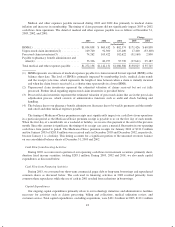Humana 2003 Annual Report Download - page 44
Download and view the complete annual report
Please find page 44 of the 2003 Humana annual report below. You can navigate through the pages in the report by either clicking on the pages listed below, or by using the keyword search tool below to find specific information within the annual report.
Investment and Other Income
Investment and other income totaled $129.4 million in 2003, an increase of $43.0 million from $86.4
million in 2002. This increase resulted primarily from an increase in net realized capital gains due to a $15.2
million gain from the sale of a venture capital investment and lower investment impairment losses, a result of an
improving market. We recorded investment impairment losses of $3.2 million in 2003 compared to $27.2 million
in 2002. Higher average invested balances offset lower interest rates. The average yield on investment securities
was 3.5% in 2003, declining from 4.6% in 2002.
Medical Expense
Total medical expenses as a percentage of premium revenues, or medical expense ratio (MER), for 2003
were 83.5%, decreasing 10 basis points from 83.6% for 2002.
The Commercial segment medical expense ratio for 2003 was 82.9%, decreasing 60 basis points from
83.5% for 2002. The improvement in the MER primarily resulted from per member premium rate increases in
excess of medical cost trends for our large group customers and the attrition of groups with higher medical
expense ratios. We expect the Commercial segment MER to increase between 100 to 130 basis points in 2004
primarily due to competitive pricing pressures and the pass through of increased administrative expense
efficiencies to customers in the form of lower rates.
The Government segment medical expense ratio for 2003 was 84.3%, increasing 50 basis points from 83.8%
for 2002. This increase primarily was attributable to TRICARE as a result of having a higher level of BPA
activity in the prior year.
SG&A Expense
Total selling, general and administrative, or SG&A, expenses as a percentage of premium revenues and
administrative services fees, or SG&A expense ratio, decreased 50 basis points in 2003 primarily because of a
decrease in severance and related employee benefit costs of $29.0 million, the absence of 2002 expenses of $30.1
million associated with a contingent contractual provider dispute and other items, offset by an increase in
building impairments of $14.8 million.
Increased operating efficiency led to the consolidation of seven service centers into four and an enterprise-
wide workforce reduction affecting administrative expenses in both 2003 and 2002 by recording expenses for
severance and related employee benefit costs and building impairments. Severance and related employee benefit
costs, more fully described in Note 10 to the consolidated financial statements, amounted to $11.2 million in
2003 and $40.2 million in 2002. The 2002 severance amount primarily related to the service center consolidation.
Building impairments, more fully described in Note 4 to the consolidated financial statements, amounted to $17.2
million in 2003 and $2.4 million in 2002.
During 2002, we recorded $30.1 million of administrative expenses for a contingent contractual provider
dispute and other items associated with our 1997 acquisition of Physician Corporation of America, or PCA. The
$30.1 million of expenses in 2002 resulted from three issues. First, on January 28, 2003, we settled a dispute with
a provider for $8.3 million primarily regarding old claims of PCA subsidiaries dating prior to Humana’s 1997
acquisition. Second, during the fourth quarter of 2002, as a December 2, 2002 trial date approached, efforts
intensified to reach settlement of an old PCA shareholder dispute for periods prior to Humana’s 1997 acquisition
of PCA. As a result, we accrued $15.7 million because the loss was probable and the amount could be reasonably
estimated. We reversed $1.8 million of this reserve when the final settlement was paid during the third quarter of
2003. Third, in connection with an agreement reached in November 2002, we partially wrote-off a note
receivable of $6.1 million from the purchaser of our workers’ compensation business which was sold in 2000.
The agreement with the purchaser resulted when a significant customer contract was terminated in the fourth
quarter of 2002. We acquired the workers’ compensation business in connection with the 1997 PCA acquisition.
36
























